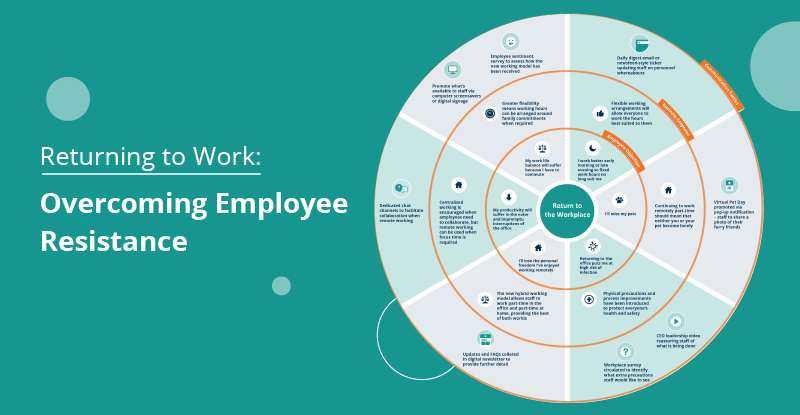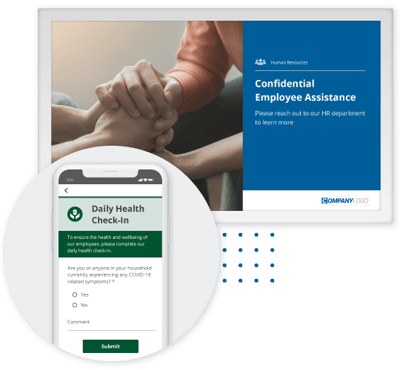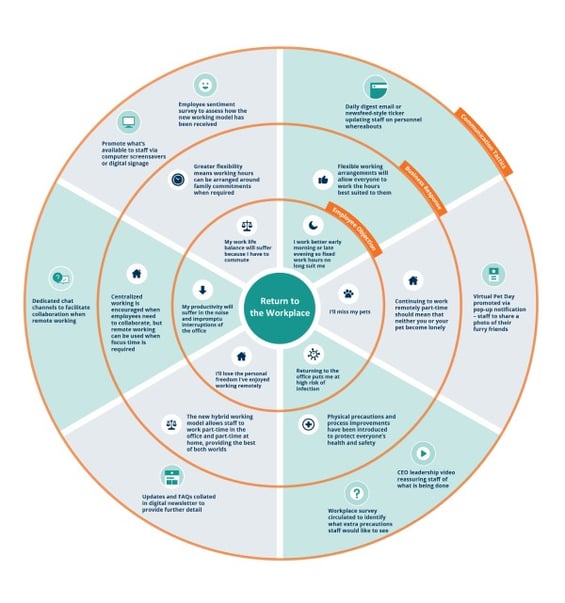
Returning to the workplace is a reality for many organizations this year. But evidence reveals that staff are less positive about this change than employers. How can this be reconciled?
Research shows that 83% of CEOs want their employees to return to the office, but only 10% of employees want to return.
The gulf between these numbers reveals a serious business risk. A failed return to work program will result in declining morale, rising turnover, ignited rumors and eroded productivity. Businesses that have suffered the impacts of COVID-19 last year simply cannot afford this in 2021.
So what’s behind employees’ reluctance to return to centralized work? And how can HR Managers or other business leaders address these objections before reluctance turns into resistance?

The Changing Nature of Work
For employees returning to work after COVID, the transition will feel unsettling. Much may have changed in the interim. Some of their old teammates may not be returning at all.
Many organizations are switching to a hybrid working model, with some employees based full-time in the office and others working part-time at home. It’s an approach exemplified by Spotify, the latest company to shift to a flexible “Work from Anywhere” model. By one estimate, 25-30% of the workforce will be working from home multiple days each week by the end of 2021.
Transitioning to a new mode of work will affect working location, commuting, role responsibilities, work/life balance, family duties, and more. Operating a hybrid workforce complicates this further. Inconsistencies in where and when employees are working centrally can undermine processes and disrupt collaboration.
How Employees Respond to Change
During times of significant change, more than 80% of employees experience “cultural tensions.” Competing priorities they don’t know how to balance, which can result in a negative emotional response.
This is even more pronounced when the proposed change is in opposition to the desires of many employees – as is the case for returning to work.
Left unaddressed, this emotional response results in dissatisfaction and disengagement. Staff who are unsettled or unhappy don’t commit to the change and perform their roles at reduced levels of effort. Online forums and chat channels become enablers for the spread of negative opinions.
Addressing Employee Objections
Some level of employee resistance to change is inevitable. It’s human nature to feel cautious around new things and to prefer the status quo. But it is possible – and desirable – to counter employee objections before they manifest as resistance that could derail your project.
Communication is the biggest influence on business transformation success. At companies where management communicates openly about the transformation’s progress, employees are 8 times more likely to report a successful outcome.
The new flywheel chart shown here demonstrates how to address employee objections through communications.
It’s focused on your change initiative at the center. Outward from there, the surrounding ring summarizes common employee objections. The next ring details what the business response should be. The final ring recommends communications tactics to achieve the business response and resolve the objection.
For example, one of the most common objections to returning to centralized work is the risk to personal health. Using the flywheel model, this objection can be addressed as follows.
|
Employee Objection |
Business Response |
Communication Tactics |
|
Returning to the office puts me at high risk of infection |
Physical precautions and process improvements have been introduced to protect everyone’s health and safety |
|
This approach can also be helpful in identifying key pieces of information to convey in your employee messaging, such as a return to work letter from the employer.
Communication Tips on Returning to Work After COVID
Consider the following communication tactics to promote positivity and minimize resistance to returning to work.
-
Incorporate visual cues in your messaging to support employee cognition and quicken information processing. The use of visuals in brand communications improves learning by up to 400% and can help foster a sense of belonging which builds loyalty.
-
Develop activities that increase employee awareness, interest, and confidence in returning to work. Reinforce key messages to build commitment and support.
-
Encourage your leadership team to champion the return to work and act as role models through their behavior and messaging.
-
Identify the key influencers and thought leaders among your employees. Target messages specifically to them and involve them in your return to work program early. In this way, they can become valuable change agents who can help persuade others.
-
Adapt your messaging formats for each stage of your return to work program. In the early stages, employees can’t take in too much information at once. They need bite-sized messages if they are to understand and retain information. Lengthy emails are unlikely to be effective. Desktop Alerts which provide short, sharp, and concise content are more likely to get read.

Building Culture Through Communication
Business leaders cite culture as the number one barrier to transformations. Introducing an ongoing internal communication and engagement program can help foster a strong company culture that supports successful change. This is essential in an evolving or hybrid working environment.
Look for opportunities to get staff involved, celebrate team and individual achievements. Use social and engagement channels such as corporate screensavers to promote cultural initiatives and employee surveys to encourage feedback.
Managing a successful return to work requires messaging that addresses a range of topics, themes, and audiences. Certain messaging will convey factual information that employees need to understand. Others will require employees to perform specific actions. And some will provide supporting content to support well-being and morale. Examples include:
-
Inform – What changes are being made to physical workspaces? When are they happening?
-
Engage – How can employees provide feedback on what they’d like when returning to work?
-
Motivate – What support services are available to employees during the transition?

Returning to the workplace should be a cause for celebration. It’s an opportunity to reengage employees and refocus efforts, as well as represent an important milestone in life reverting to normalcy after the disruption of COVID-19. The key to a successful transition lies in identifying and resolving employee concerns.
Need to deliver an effective return to work program? Download our free white paper: Time For Change - Managing A Successful Future Of Work.



